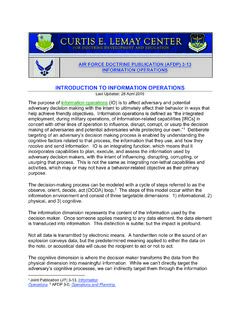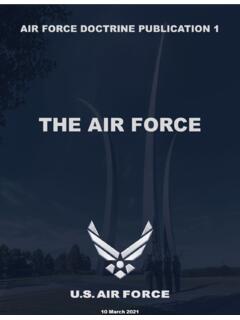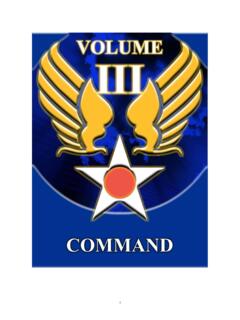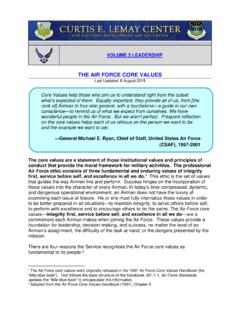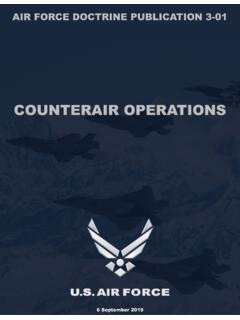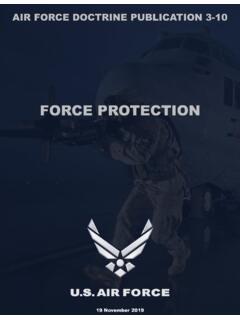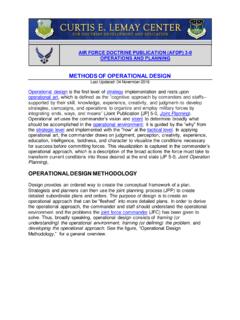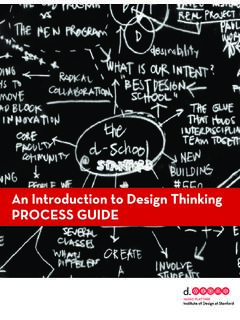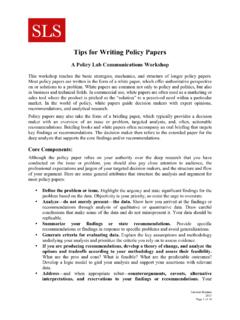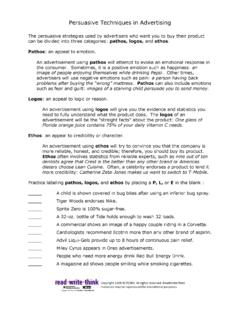Transcription of APPENDIX A: CENTER OF GRAVITY ANALYSIS METHODS - AF
1 APPENDIX A: CENTER OF GRAVITY ANALYSIS METHODS Last Updated: 04 November 2016 A CENTER of GRAVITY (COG) is a source of power that provides moral or physical strength, freedom of action, or will to Analyzing COGs provides a means of focusing friendly efforts, both offensively and defensively. There are a number of tools and techniques available to identify and analyze COGs. Joint doctrine (JP 5-0, Chapter IV) presents one model, but there are others, each with its own assumptions, strengths, and weaknesses. All, however, attempt to relate what is critical to what is vulnerable in some useful way to identify and prioritize critical, targetable vulnerabilities. Each of the common METHODS is examined below, with a short summary discussing the strengths and weaknesses of each. Caution. In the same sentence in which he first described a CENTER of GRAVITY Clausewitz made it clear that it was only a metaphor, a picture to help understand the main thing.
2 The techniques of CENTER of GRAVITY ANALYSIS even the practice of using COG as an acronym, highlight the extent to which military planning can uncritically employ shortcuts. The process of COG ANALYSIS may also lead to a mental image of a static adversary. The best correctives to this oversimplification are to study the adversary thoroughly, respect the adversary as capable and willing to fight wherever and whenever possible, and accept that the adversary could be employing a strategy which we may find hard to understand. Addressing these challenges can be aided by the use of red teams. One thing all models have in common is that any COG a commander chooses to affect should always be linked to one or more objectives. If the objective changes, the COG may also change. At the strategic level, a COG could be one or a set of leaders (political or military), an alliance, a military force, a set of critical functions, or national will.
3 At the operational level, a COG is often associated with an adversary s military capabilities, such as a powerful element of the armed forces, but could also include other capabilities in the operational environment. COGs can emerge or change over time, due to the interplay of friendly, adversary, and other forces in the operational environment. They may be based on the end state, mission, and objectives as well as the adversary s strategy. COG ANALYSIS takes place as part of joint intelligence preparation of the operational environment, mission ANALYSIS , or both. Commanders should consider not only the adversary s COGs, but also identify and protect their own COGs. An effects-based approach to operations should orient on creating effects in time and space that decisively affect a COG. 1 Joint Publication (JP) 5-0, Joint Planning. AIR F ORCE DOCTRINE PUBLICATION (AFDP) 3-0 OPERA TIONS AND PLANNING THE JOINT MODEL The model endorsed in joint doctrine (JP 5-0) is also known as the Marine Corps model, the CG-CC-CR-CV Model, and the Strange Model, for its developer, Dr.
4 Joe Strange of the Marine Corps War This model is depicted in the figure, Joint COG Model and an example of its application is given in the figure, Joint COG Model Example (World War II). Description. This model starts with the joint definition of a COG as a source of strength, freedom of action, or will to act. It then analyzes the COG to determine, (in order) its: Critical capabilities (CCs): those means that are considered crucial enablers for a COG to function as such (and are essential to the accomplishment of the specified or implied objectives). Critical requirements (CRs): essential conditions, resources, or means for a CC to be fully operational. Critical vulnerabilities: CRs, or components thereof, that are deficient or vulnerable to attack (or other effect) that will create decisive or significant effects on the COG. COGs are nouns tangible or intangible sources of power. CC can be thought of as verbs things a COG does.
5 CRs are nouns those things a critical capability needs to function as such. CVs are those critical requirements that are vulnerable. 2 Note that this model uses the abbreviation CG for CENTER of GRAVITY . For all purposes, CG and COG should be considered synonymous. See Dr Joseph Strange, Centers of GRAVITY and Critical Vulnerabilities: Building on the Clausewitzian Foundation So That We Can All Speak the Same Language. Joint COG Model Advantages. This is an intellectually complete manner of analyzing COGs. It clearly relates critical elements to vulnerabilities via a logical causal chain. It has been endorsed in joint doctrine and is taught in some form in most, if not all, Service schools. Disadvantages. This method can be difficult to operationalize to work through intellectually in such a manner that it yields actionable tasks and targets.
6 Effective application of this approach requires a comprehensive and detailed understanding of adversary systems. Doing it properly thus takes time. This model has significant power, but analysts may sometimes find it difficult to derive valid critical capabilities or properly determine vulnerabilities from requirements. (Experience has shown that these are the most common points at which the model breaks down. ) Analysts should use care and have a very thorough understanding of the system they are analyzing. This method also tends to be more labor and information intensive than other models. THE STRATEGIC RING MODEL This model is also known as the five-rings model and as Warden s Rings, after its developer, Col (Ret) John A. Warden III. Description. The basic structure of this model is not of COGs, per se, but of characteristics common to all living organisms. This is depicted in The Strategic Ring COG Model.
7 It posits that there are one or more COGs within each ring of the systems; it is thus really a very simple systems ANALYSIS tool as much as it is a tool for COG ANALYSIS . The model maintains that there are certain functions necessary for every system to function: A command and control (C2) and information processing system, such as the leadership and C2 apparatus within a military or the central nervous system of a human body. The processes necessary for the survival of the system, such as communications, food production and distribution, financing, and manufacturing in a state, or respiration and blood circulation in a living body. Joint COG Model Example (World War II) A system of infrastructure, like the electrical power distribution or transportation systems of a nation, or the bone and vascular systems of a body. A population, such as the aggregate of individuals within a nation or armed force or the cells within a body.
8 A fighting or defense mechanism, such as the fielded armed forces of a nation or the immune system of a body. (Note that Col [Ret.] Warden chooses to call this ring, fielded forces. ) Advantages. This model shows the central value of leadership as a COG it helps demonstrate the value of shock and dislocation on all rings through effects on leadership. It also shows that airpower does not have to fight its way through enemy fighting mechanisms (fielded forces) to affect the critical adversary systems defended by them, as other forms of military power often do. Disadvantages. This model makes no distinction between what is critical and what is vulnerable; in fact, it confuses the two. If applied blindly ( we ve drawn our five rings and those are our COGs ), it can encourage mirror imaging of the adversary s system and lead to a mechanistic and reductionist inputs-based approach to targeting. (Experience has shown that some teams using only this method will list the five categories as the COGs and immediately begin listing customary target sets below them.)
9 This is the antithesis of effects-based targeting.) Finally, this model considers the subject system in isolation, ignoring its connectivity to external systems and other aspects of the operational environment. This is the antithesis of a systems approach to COG ANALYSIS . THE NATIONAL ELEMENTS OF VALUE MODEL This is also known as the NEV model and Barlow s Model, after its originator, Col (Ret) Jason Barlow. Description. This model is generically similar to the strategic rings model, but seeks to show a greater degree of interconnectivity as well as connectivity to external systems. The national elements of value include: Leadership: The political and military decision-makers within the government. The Strategic Ring COG Model Industry: All of a country s manufacturing, agriculture, research and technical enterprises as well as those parts necessary to support them, such as power production, water supply, and raw materials.
10 Armed forces: Self explanatory. Population: A country s ubiquitous features that are important, but hard to categorize and quantify; , nationalism, morale, the will of the people, esprit de corps, ethnocentrism, ability to endure hardship, and religious conviction or fervor. Transportation: All modes. Communications: The physical means thereof. Alliances: The friends, trading partners, and neighbors, from which a country receives support for continuing the conflict. NEVs are interdependent and self-compensating. They are a critical means of system adaptation, redistribution, and recuperation. The lines connecting NEVs (depicted in the figure, The National Elements of Value Model ) are constantly varying in size and texture, as they represent the strength and direction of influence, both formal and informal, and the various lines of command, control, and authority inherent among the elements.
